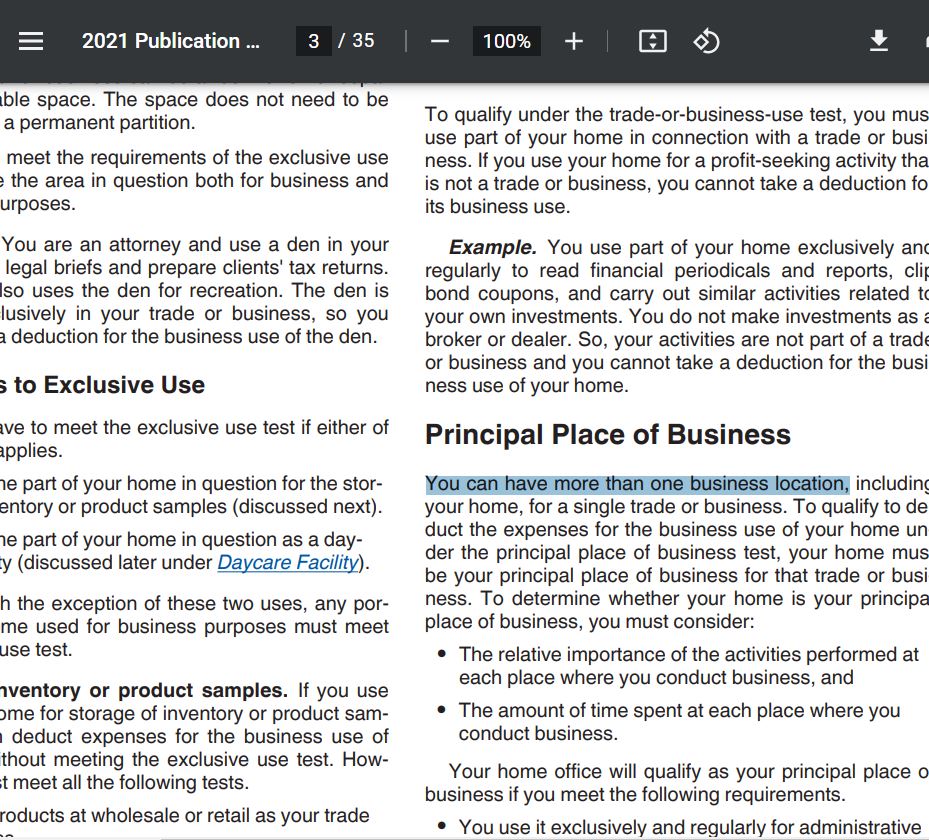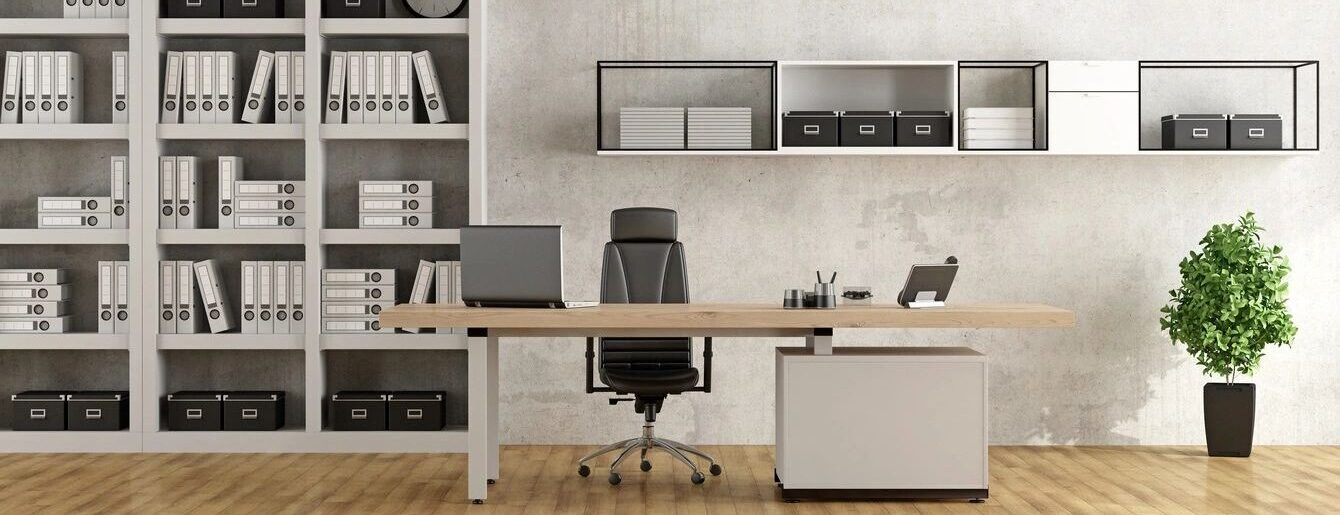If you have an office outside your personal home, can you have a tax-deductible office inside your home for the same trade or business?
Question: Can you deduct a home office if you also have a non-home office? Answer: Yes!
As the tax reduction specialists for the self-employed we navigate through the home office deduction issues regularly. We know what the IRS looks for and what you will not get away with. SO let's make sure your tax reduction strategy will hold up to the IRS code.
Deduct a Home Office? What IRS Publications Say
As an enrolled agent, Ken Weinberg is well-versed on the ever-changing codes in the IRS. Let’s start with some quotes from IRS publications that show you how the IRS views the office-in-the-home deduction when you have an office outside the home for the same business. The home office is going to qualify for deduction when you make it an administrative office for your business. This is true regardless of how you operate your business: proprietorship, LLC, or corporation. If you operate as a corporation, you may not deduct an office in your home that you rent to the corporation.
Planning tip. The S corporation owner typically obtains maximum benefits from the home office when using the reimbursement technique. Set up an appointment to learn more.
IRS Publication 587 About Deducting a Home Office
In IRS publication 587, the IRS says this: Your home office will qualify as your principal place of business for deducting expenses for its use if you meet the following requirements:
 The quote above mirrors the law and the legislative history, as you will see below. Note the following points:
The quote above mirrors the law and the legislative history, as you will see below. Note the following points:
- The administrative office is a “principal” office.
- You must use this office exclusively for business.
- You must use this office regularly for business. (see regular use post)
- You must do your administrative work in your home office.
- You must not do your administrative work in the office outside the home.
Here is a second important quote from IRS Publication 587. On page 3 of this publication, it is written, under "Principal Place of Business" that:
You can have more than one business location, including your home, for a single trade or business.
It is very straightforward: You may have more than one office for your business, including an office in your home.
IRS Publication 587: Your Administrative Office is a Principal Office.
Let’s say you are driving a vehicle that costs you $1.00 a mile to drive. Further, let’s say that your personal commute to and from your office is 24 miles a day, five days a week, 48 weeks a year. That’s $5,760 in new deductions.
Let’s look at one other quick example. Say you are driving a $50,000 vehicle 40 percent of the time for business. Now say that eliminating commuting with your administrative office increases your business use of this vehicle from 40 to 80 percent. Here are the results:
- With 40 percent, you were depreciating a $20,000 business vehicle (40 percent times $50,000).
- With 80 percent, you are depreciating a $40,000 business vehicle (80 percent times $50,000).
- You might benefit even more by driving more than one vehicle for business.
What the Legislative History Says
The IRS does a good job of summarizing the tax-deductible home office in its publications. The IRS’s overall approach in its publications is simply to reiterate what the law says.
What follows is the legislative history of this topic from the Ways and Means Committee’s report that accompanied passage of the new home office law in 1997 (effective in 1999). The first thing lawmakers looked at was the present law. Then they considered the reasons to make changes to that law. Finally, they looked at explanations of how the new law would work.
Present law (1997). In Commissioner v. Soliman, 113 S.Ct. 701 (1993), the Supreme Court reversed lower court rulings and upheld an IRS interpretation of Section 280A that disallowed a home office deduction for a self-employed anesthesiologist who practiced at several hospitals but was not provided office space at the hospitals.
Although the anesthesiologist used a room in his home exclusively to perform administrative and management activities for his profession (i.e., he spent two or three hours a day in his home office on bookkeeping, correspondence, reading medical journals, and communicating with surgeons, patients, and insurance companies), the Supreme Court upheld the IRS position that the “principal place of business” for the taxpayer was not the home office, because the taxpayer performed the “essence of the professional service” at the hospitals.
Reasons for change. The [Ways and Means] Committee believes that the Supreme Court’s decision in Soliman unfairly denies a home office deduction to a growing number of taxpayers who manage their business activities from their home.
Thus, the statutory modification adopted by the Committee will reduce the present-law bias in favor of taxpayers who manage their business activities from outside their home, thereby enabling more taxpayers to work efficiently at home, save commuting time and expenses, and spend additional time with their families.
Moreover, the statutory modification is an appropriate response to the computer and information revolution, which has made it more practical for taxpayers to manage trade or business activities from a home office.
Explanation of Provision. Section 280A is amended to specifically provide that a home office qualifies as the “principal place of business” if
-
- the office is used by the taxpayer to conduct administrative or management activities of a trade or business and
- there is no other fixed location of the trade or business where the taxpayer conducts substantial administrative or management activities of the trade or business.
As under present law, deductions will be allowed for a home office meeting the above two-part test only if the office is exclusively used on a regular basis as a place of business by the taxpayer and, in the case of an employee, only if such exclusive use is for the convenience of the employer.
Thus, under the bill, a home office deduction is allowed (subject to the present-law “convenience of the employer” rule governing employees) if a portion of a taxpayer's home is exclusively and regularly used to conduct administrative or management activities for a trade or business of the taxpayer, who does not conduct substantial administrative or management activities at any other fixed location of the trade or business, regardless of whether administrative or management activities connected with his trade or business (e.g., billing activities) are performed by others at other locations.
If a taxpayer conducts some administrative or management activities at a fixed location of the business outside the home, the taxpayer still will be eligible to claim a deduction—so long as the administrative or management activities conducted at any fixed location of the business outside the home are not substantial (e.g., the taxpayer occasionally does minimal paperwork at another fixed location of the business).
In addition, a taxpayer’s eligibility to claim a home office deduction under the bill will not be affected by the fact that the taxpayer conducts substantial non-administrative or non-management business activities at a fixed location of the business outside the home (e.g., meeting with, or providing services to, customers, clients, or patients at a fixed location of the business away from home).
If a taxpayer in fact does not perform substantial administrative or management activities at any fixed location of the business away from home, then the second part of the test will be satisfied, regardless of whether or not the taxpayer opted not to use an office away from home that was available for the conduct of such activities.
However, in the case of an employee, the question of whether an employee chose not to use suitable space made available by the employer for administrative activities is relevant to determining whether the present-law “convenience of the employer” test is satisfied.
What the Internal Revenue Code Says
The above background is used by the IRS and the courts to explain the law. The actual wording of the law appears below:
For purposes of [a home office] qualifying as a principal place of business, the term “principal place of business” includes a place of business which is used by the taxpayer for the administrative or management activities of any trade or business of the taxpayer if there is no other fixed location of such trade or business where the taxpayer conducts substantial administrative or management activities of such trade or business.
Deduct a Home Office: Conclusions
You can see that the law clearly authorizes the administrative office inside the home. The legislative history shows that the new law is a direct result of lawmakers finding that the Soliman case produced an unfair result. Thus, the change in the law gives you the opportunity to do several things:
- Create an office in the home as an administrative office.
- Have an office outside the home for business activities other than your administrative activities.
- Deduct, as business trips, the trips from your home to your outside-the-home office and back.
Before claiming any of these deductions, consult with the small business tax experts at Ken-Mar Tax.
Contact Us
If you’ve been frustrated dealing with the IRS, or you just don’t want to deal with the IRS, contact Ken Weinberg to explain your situation and find out what Ken-Mar Tax would charge to handle your situation and avoid dealing with the IRS all together.
- If you have back taxes and want to know the timeline and/or costs to get your back taxes resolved
- If you own a small business and want to discuss tax reduction strategies for the self-employed
- If you’re worried your last tax expert wasn’t doing the best they could have and want a second opinion…
Contact Ken Weinberg to learn more about our small business tax consultant services and set up a free consultation by filling out the form on this page.




